SMS cards were originally created for the IBM 7030 Stretch supercomputer.[2] The idea of SMS cards was to have a few standard cards that formed the building blocks that could be combined to build a computer. Each card provides a basic function such as a flip flop or a few logic gates. The board below, for example, implements three AND gates[3], using a relatively slow type of logic called diode-transistor logic that only requires one transistor per gate. You can see the transistors (silver circles) and diodes on the right, while resistors and inductors[4] are on the left.
SMS cards became the basis of of IBM's systems and were used on computers such as the IBM 1401, IBM 1620, and IBM 7000 series, as well as in tape drivers, printers, and other peripheral devices. SMS cards continued to be used well into the 1970s, even after integrated circuits made discrete transistors obsolete: advanced mainframes of the 1970s such as the IBM 370 still used multiple SMS cards for power supply regulation.
The picture below shows the back of an SMS card. The 16 gold-plated contacts on the end plug into a socket in the computer, connecting the card. The circuit board pattern is considerably more complex than necessary; depending on the components installed, one circuit board can implement several different SMS cards, reducing manufacturing costs.
Since each SMS card is so basic, it takes thousands of them to build a computer. The picture below shows an IBM 1401 mainframe, a very popular business computer of the 1960s. One of the racks of cards (which IBM confusingly calls a "gate") is open, showing more than 125 SMS cards plugged in. The circuitry in this specific gate below implements timing and logic functions (such as addition and subtraction). For maintenance, each gate swings out of the computer simply by pulling on the handle above the fan. The 1401 has 24 gates like this full of SMS cards, each one implementing different functionality of the computer. In total, the IBM 1401 computer contains more than 3400 SMS cards.
The picture below is a closeup of the SMS cards plugged into a gate in the IBM 1401. At the top of the gate, wiring harnesses connect this circuitry to other parts of the computer. On the back of each gate, the SMS cards are connected together by wirewrapping.
Although the original idea of SMS cards was to standardize on a few types, the number of different cards exploded as time went one, resulting in thousands of different SMS card types. As well as logic gates, SMS cards can have an amazing variety of functions such as an oscillator, voltage regulator, core memory, fuses, printer hammer driver, disk speed detector or temperature switch. The 1401 computer alone uses 162 different types of SMS cards.
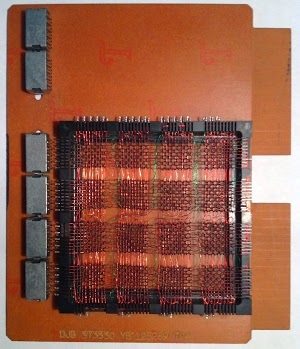
Information on particular SMS cards is surprisingly hard to find, so I made a database of SMS cards, collecting information on 900 different cards. Given the historical importance of SMS cards, I think information on this technology should be preserved. I pulled together information from scans of old IBM documents and a bunch of other sources (which was more work than I expected). You can access the database at righto.com/sms and see the wide variety of cards along with photos, descriptions, schematics, and the devices that use them.
In the 1960s, IBM made SMS cards by the millions, but most of them have been scrapped for the gold in their contacts.[5] You can still find a few SMS cards on places such as eBay[6], though, where they are collectables for about $15 each. If you want to see SMS cards in operation, the Computer History Museum in Mountain View has live demonstrations of the 1401 computer on Wednesdays and Saturdays (schedule). Check it out if you're in the area.[7]
In conclusion, SMS cards are an important part of computer history of the 1960s. It's hard to imagine computers before silicon, but SMS cards provide a window into that time. While the technology of today's computers is hidden away in microchips, the whole circuitry of older computers is exposed, letting you see how individual components make simple logic circuits, these boards are combined into functional units, and the computer is built from these units. And if technology had progressed slightly differently, this area might be known as Germanium Valley instead of Silicon Valley.
Notes and references
[1] For the first few years, transistors were made of germanium, not silicon. In 1954, silicon transistors were introduced and rapidly took over because they were more stable and had better operating characteristics. Germanium transistors are almost entirely obsolete now, but they still remain popular in fuzz and distortion pedals, where they are said to give a better sound than silicon transistors.[2] The IBM 7030 Stretch supercomputer is described in detail in The engineering design of the Stretch Computer, 1959. The Stretch used 22,000 SMS cards, of which 4,000 were double cards. Stretch used just 42 different types of SMS cards (24 single-width and 18 double-width), with two types of cards making up more than half of the computer. In comparison, the IBM 1401 is a much smaller system with just 3047 total cards, but it has more than 120 different card types. Some cards can be modified by jumpers; counting the variants the 1401 has 162 different card types. (The 3047 figure is for the Computer History Museum's IBM 1401; the figure will vary for models with different optional features.)
[3] The JGVW SMS card has three two-input AND gates, running on -12V. Inputs are +6V or -6V, outputs are -12V or 0V. (SMS cards use a variety of voltages for their inputs and outputs.) Details on this SMS card are here.
[4] You don't see inductors in logic circuits very often these days, but inductors were commonly used on SMS cards to improve performance. The inductors filtered the output signals to make the signal transitions faster.
[5] To figure out the value of the gold in an SMS card, I measured the gold contacts as 2.26mm by 10.74mm with 1.62mm by 1.13 mm traces, which works out to 24.27mm^2 per contact. With 16 contacts and a thickness of 2.54 microns, that works out to just over 1 cubic mm of gold per SMS card. At the current gold price of $1200 per ounce, that's 79 cents of gold per board. In total, the 3047 SMS cards in an IBM 1401 contain $2400 worth of gold.
[6] On eBay, two sellers of SMS cards that I have found to be very helpful are rolyath and maisorbus.
[7] Thanks to the members of the 1401 restoration team, especially Randall Neff, Ed Thelen, Jay Jaeger and Tim Coslet for their help with my SMS card exploration.
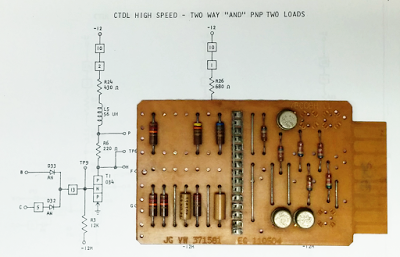
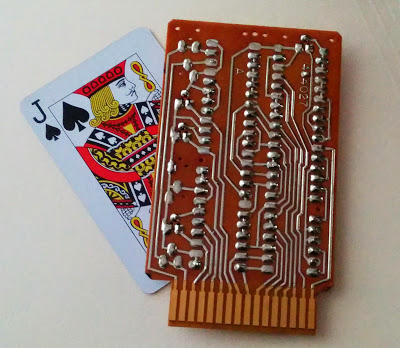
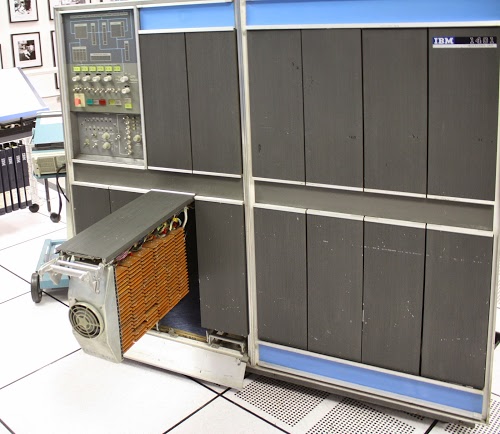
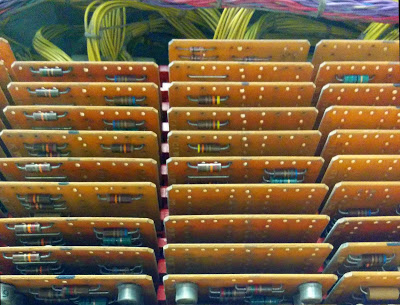
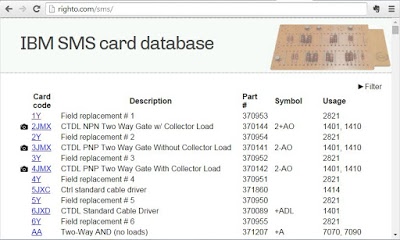
16 comments:
I thought it was interesting that they did use PCBs even then; somehow I had thought that everything was wire wraps and other harnesses back in the day.
The use of a generic PCB populated different for several card types (and the fact that they didn't use PCBs for "gate" or mainframe backplanes) speaks to what must have been a very high setup cost for a PCB layout.
It looks like these were all 2-layer boards?
Hi Dan! The boards are all 1-layer, i.e. one layer of traces on the back, and components and jumpers on the front.
I think the wire-wrapping on the backplanes was used for flexibility. Field engineers would actually move wires around if a user purchased a new feature. Users of the 1401 could buy additional instructions such as comparison, multiplication, or indexing, and the engineer would add more cards and change a few wires.
I used to fix these machines. On a 5320, we would upgrade the machine from 9.2 MB to 13.4 MB by moving a wire from one position to another. We also did engineering changes (ECs)by cutting the pin connection and rewiring. It was a great time to be a field service engineer.
I can see where you got the pictures :-)
I should have two or three SLT cards somewhere.
Very interesting, thank you!
Ah, memories of Radio Shack, and the Big Bin o' Boards.
If memory serves, RS sold these things with the connectors broken off.
I may still have a few, stuck in old coffee cans out in the garage, in varying states of component removal.
And, looking at the PCB layout, I'm having flashbacks to Bishop Graphics, decals, and tape....
Eric, if you find any SMS cards in your garage that aren't on my list, please send me information and I'll add them.
There's actually a lot more SMS gold than that. The socket pins also need (and have) gold where the card fingers contact them.
But it's not plated, rather it's a tiny solid button. They are not visible unless the socket is broken open.
My assessments have varied, but there are about 450 of these dots to 1 gram, though they also contain 10-20% silver.
I have over 7000 SMS sockets that I've been dragging around for decades, but after 35 years, I'm finally getting around to recovering the gold in them.
These came from a 1401 and a 7044 that were installed at Melbourne University until the late 1970's.
I wrecked the SMS cards for the gold many years ago, but only later appreciated their historic interest, though I did keep the core memory gate of the 1401 intact.
My very old SMS card website:-
http://members.optushome.com.au/intaretro/SMSCards.htm
Cheers,
Rob Storey
I have no citation, but it feels like this setup was the inspiration for the cinematic core of HAL9000. Dave, disengages small cards when 'killing' HAL
w@David Galloway, there's also the idea of "isolinear chips" in Star Trek: The Next Generation (e.g., http://en.memory-alpha.wikia.com/wiki/Isolinear_chip) which were often shown in large numbers, arranged in colorfully illuminated banks behind wall panels.
I have that very same memory card I removed from an IBM 2821 controller. It was one of many in an array. We used to shmoo the memory buffer by adjusting the voltage up and down while running a print diagnostic to get the sweet spot. The 2821 ran 1403 printers and 2540 card reader / punches on IBM 360/ 370 mainframes .
I was a Field Engineer with IBM. The SMS cards were also used in the 2415 9-track Tape Drives. Got a call from a customer one day with one of the drives getting read errors. Turns out we found the pre-amp for track 1 was clipping the positive side of the signal; visible on an oscilloscope. That particular SMS card was out of stock at the regional parts center. A "Code A" parts order would have take two days to arrive. We had a set of diagrams on microfiche such as you have in your database and analyzed the defective circuit. We removed the defective diode and transplanted with another one from an unused circuit on the same card. Voila! We had it fixed on just under an hour. The customer was extremely joyful to get back into production for his payroll application.
I recently found a box of 225 cards on a flea market. I have no idea how they came to be there, but I bought the lot. It seems I have a few cards that are missing in the database. Would it be interesting for you to add them to the data base? I do not know their function at all, but that might be someone elses knowledge maybe?
Two of them are marked FHA and FRF, two others are not punched at all, but written on. One says YFH, and the other does not have any text like that, but numbers.
I have about a hundred cards more to go through, so there might be more.
Best regards
Roland
Roland, yes, if you have cards that aren't in my database, I'd be interested in adding them. What would work best is if you can send photos of both sides, along with the alphabetical code if any (since it's hard to read from photos). The part number (6 digits, starting with 3) next to the alphabetical code would also be useful. My email is firstname.lastname@gmail.com.
Thanks,
Ken
A few more details about the SMS boards:
(1) The boards only had traces on one side, the bottom. Many wire jumpers were used on the top side where traces couldn't be run directly.
(2) The molded inductors were used to slightly improve the waveform rise times. You see the transistors were slow, with risetimes around two microseconds, and the backplane wires had high capacitance, so a little inductance helped improve the transition times.
(3) Many cards had a primitive type of PROM: a row of like twelve snippable jumpers. You could change the board logic function by snipping away some jumpers.
(4) The board material was rather cheap paper and phenolic with the traces rather loosely bonded to the board. The boards could not tolerate a hot soldering iron, the traces would just peel off. Of course back then we didn't have temperature controlled soldering irons, just 47-watt irons.
About servicing these cards-- Around 1974 I was playing with a CDC 160A computer that was dead. Poking with the console switches I found out that one bit of the memory always read back as a "1". The logic was on smaller than SMS cards, like playing-card sized with test points at the card edge. Pretty quickly I figured out one of the core memory sense amps was dead. Since there were 12 of them it was easy to compare voltages and I quickly figured out that one little germanium diode was very leaky. I scavenged a glass diode from a random very different PC board that was lying around and that immediately fixed the problem. Still remember that victory 47 years later! There were lots of less pleasant experiences before and after that that resulted in smoke and sparks.
Post a Comment